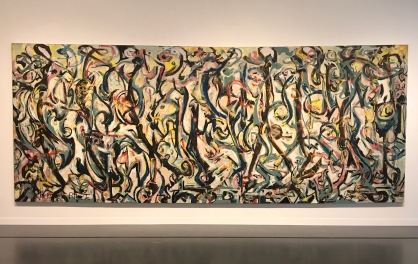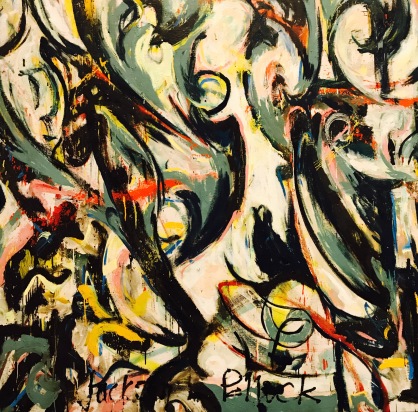Pollock’s Mural
August 5, 2017

I was finally able to view a Jackson Pollock. Not just any Pollock, but arguably the greatest Pollock — Mural. Certainly the greatest in stature, at almost 9’x20′, if not the greatest artistically. And if not the “best,” it was at least a turning point when Pollock, who was commissioned by wealthy socialite Peggy Guggenheim to fill a wall in her townhouse, began painting large-scale works.
Much has been written about the painting. Pollock, a relatively unknown artist at the time, was hired by Guggenheim in June of 1943. He received a $150 per month stipend (equal to about $2100 today) and was to have the work ready for a show in November of the same year. Legend has it that when November rolled around, the giant canvas remained untouched. Pollock claimed to have completed the painting during one creative outpouring sometime in late December (later testing proves the work was not entirely painted at one time, however), and said that the painting came from an inspirational vision the Wyoming native had. “(It was) a stampede…every animal in the American West, cows and horses and antelopes and buffaloes. Everything is charging across that goddamn surface.”
Standing alone on a hot summer day inside the cool halls of the Nelson-Atkins Museum of Art in Kansas City, MO, where Mural is on loan from the University of Iowa, I was able to truly take in the artwork. While it isn’t my favorite painting, and Pollock isn’t my favorite artist, it is something to behold. I stood as far as possible and viewed the painting as a whole. I could visualize the stampede, yet was also able to let my eyes lose focus and get lost in the free-flowing, yet repetitive, form. In some way I felt as though I was being watched. It is intriguing and mysterious.

I walked the length of the painting — back and forth — imagining how difficult it would be to keep the work consistent, yet maintain the subtle differences throughout. I stood with my face inches from the canvas, studying the lines, the splatters and perhaps unintentional drips (Mural was finished several years before Pollock started his drip paintings), the layers, the textures…and all the other tiny details hidden in the monstrous piece.



I imagined Pollock’s studio — his apartment, which had to have a wall secretly removed in order for the canvas to fit — and what it might have been like. The smell of paint and turpentine was undoubtedly and obnoxiously mixed with the cigarette smoke that hung in the air. Pollock’s thick, boozy breath clung to the wet paint, and his dripping sweat became forever a part of the artwork. Maybe a jazz record played in the background. Perhaps Pollock worked in silent solitude. What was going through his mind? Did he sit and eat a ham sandwich at some midway point, staring at the unfinished work and wondering what the hell to do next? Where were his first and last brush strokes? Was Pollock pleased with the completed work?
While I’m a lover of art, I’m no historian or expert. I see what I like, and what I like makes me wonder. Art makes me think in ways that I don’t normally. I believe that’s why I’m drawn to it. Mural certainly made me wonder. It made me think. It drew me in. If you get the chance, I highly recommend viewing it.